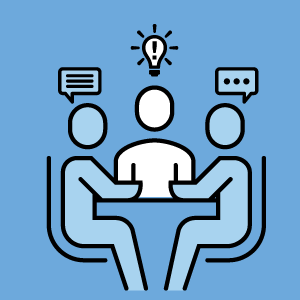According to Atlassian, U.S. workers waste about 31 hours per month in meetings. Many studies indicate that time wasted in meetings is one of the most costly problems in every industry, across every organization. In order to help you eliminate wasted time in meetings, we’ve compiled a list of nine critical requirements that, if followed, will ensure that your meetings are efficient and effective. Our consultants at The Clearing have designed, prepared for, and facilitated countless successful meetings with clients, so these steps are tried and true.
Identify Your Meeting Type
In order to understand the meeting purpose and outcomes, you must determine what type of meeting is needed. The most common types of meetings are information sharing, decision-making, brainstorming, and educating.
Define Your Meeting Purpose and Outcomes
Once you’ve determined the meeting type, it’s now time to define your meeting purpose and the outcomes you want to achieve. The meeting purpose is why people are in the room and the outcome is what you want to achieve with them. Outcomes determine what success looks like at the end of the meeting. Be sure to set realistic outcomes for the time you have allotted for the meeting so you don’t leave participants with a sense of failure and unease when outcomes aren’t met.
Distinguish Between the Facilitator and Owner
Clearly define a facilitator in charge of the meeting process, and an owner who convenes the meeting and determines the desired outcomes. The same person should not play both of these roles because they serve different purposes. The facilitator designs and manages the meeting process by ensuring the group performs at its highest possible level and achieves the desired outcomes. The owner contributes to content by convening the meeting and sharing the vision, and is accountable for tying the outcomes to organizational efforts.
Develop an Agenda and Design
Develop an agenda with topics to discuss, and create a meeting design that outlines how participants will engage with the content. While the agenda should be shared with participants, the meeting design is a plan of how to execute the meeting, and does not need to be shared with all meeting participants.
Use a Knowledge Agent
Great meeting designs will always include a specialized “knowledge agent.” A knowledge agent is a co-facilitator role assigned to listen for key takeaways, nuances, and contextual factors. The agent is responsible for creating a meeting artifact that accurately reflects what the group accomplished.
Organize the Meeting Logistics
Meeting logistics can make or break a meeting. Having a great design and agenda means little to participants if they are cramped, too cold or hot, can’t see, or don’t have proper materials. Consider site selection, room set-up, seating arrangements, catering, materials and supplies, and a “technology master” who is responsible for the technology in the room. Ultimately, you want to create an environment you think will best support the meeting outcomes.
Set the Stage
At the beginning of the meeting, review purpose, outcomes, and the meeting agenda with the group. You should also establish norms and ground rules that will support the group in reaching their desired outcomes. An example of a meeting norm is a working definition of consensus, which we will discuss in greater detail in part two of this blog series.
Hotwash After the Meeting
Hotwashing is a government term used to describe the “after-action” discussions and evaluations of an agency’s performance following an exercise, training session, or major event. Hotwashing is an exchange of honest feedback regarding the content and process of an event, and serves to identify strengths and weaknesses. Meeting facilitators should always hotwash with the internal team and the client after an event, as it will help guide future direction. Ideally, you should gather feedback from participants in person using a survey or physical paper as electronic surveys usually yield fewer responses.
Generate a Meeting Report
The final requirement for a successful meeting is to create a report that contains the insights, outcomes, highlights, and next steps that came out of the meeting. The meeting report does not need to be longer than 10 pages, and should highlight key issues as well as meeting accomplishments. Consider including a recommendations section that emphasizes the larger context of the meeting and makes suggestions for advancing the group toward their strategic goals.
Stay tuned for part two of this meeting facilitation blog series, “Six Best Practices to Facilitate Successful Meetings,” to learn specific facilitation techniques to run a successful meeting and meet the goals of a group. In the meantime, visit MeetingPRIMES.com for more information about running productive meetings.






 The Clearing’s Employee Experience
Improvement model, adapted from Itam
& Ghosh, 2020, focuses on three objectives:
The Clearing’s Employee Experience
Improvement model, adapted from Itam
& Ghosh, 2020, focuses on three objectives: 














